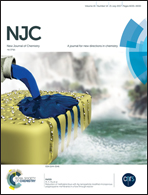Magnetic and dielectric properties of a lanthanum-doped yttrium copper titanate ceramic
Abstract
In this study, the microstructure, dielectric and magnetic properties of a lanthanum-doped yttrium copper titanate (YLCTO) ceramic are reported and have been discussed. A thin film of this ceramic was studied via atomic force microscopy, which displayed a homogeneous distribution of small and compact grains with clear grain boundaries with an average and root mean square roughness of 2.684 and 3.945 nm, respectively. The kurtosis distribution curve was found to be leptokurtic with many high peaks and a few low valleys. Powder X-ray diffraction studies demonstrated the single-phase formation of the YLCTO ceramic. A Rietveld fit of its XRD profile yielded the space group Im3, and this ceramic crystallized in the pseudo-cubic phase with no change during the Rietveld refinement. The magnetic study confirmed the presence of a transition from an antiferromagnetic to a superparamagnetic phase. The YLCTO exhibited an almost temperature independent dielectric constant from room temperature to 375 K, and then, the dielectric constant increased with temperature. The complex impedance plot exhibited two semicircles corresponding to the grain and grain boundary. The center of these impedance semicircles is below the real axis, indicating the Cole–Cole relaxation.



 Please wait while we load your content...
Please wait while we load your content...